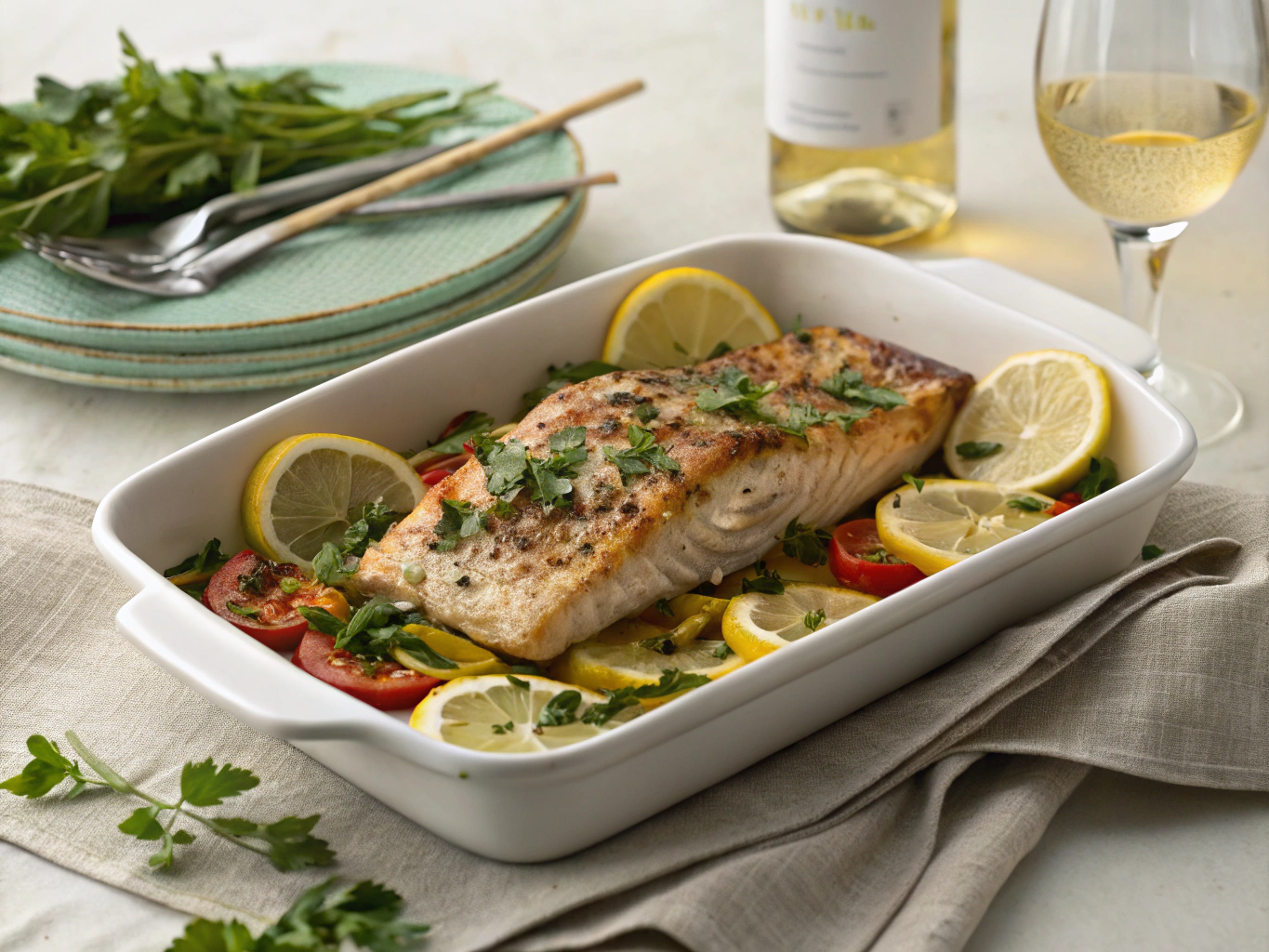Table of Contents
Introduction
Did you know that mahi mahi is one of the most sustainable seafood choices available, yet only 23% of home cooks regularly prepare it? This overlooked culinary gem deserves a spotlight in your kitchen repertoire. Our oven-baked mahi mahi recipe transforms this firm, flavorful fish into a restaurant-quality meal with minimal effort. Whether you’re a seafood enthusiast or simply looking to expand your dinner options, this mahi mahi recipe oven method delivers consistent, delicious results every time. The dry heat of oven baking enhances the fish’s natural sweetness while maintaining its moisture—a cooking technique that’s surprisingly forgiving for seafood novices.
Ingredients List
- 4 mahi mahi fillets (6 oz each, about 1-inch thick)
- 3 tablespoons olive oil (can substitute avocado oil for higher heat cooking)
- 4 cloves garlic, minced (or 2 teaspoons garlic powder)
- 1 lemon, half juiced and half sliced for garnish
- 1 tablespoon fresh parsley, chopped (or 1 teaspoon dried)
- 1 teaspoon paprika (smoked paprika offers a deeper flavor profile)
- 1 teaspoon dried oregano
- ½ teaspoon sea salt
- ¼ teaspoon freshly ground black pepper
- ¼ teaspoon cayenne pepper (optional for heat lovers)
- 2 tablespoons butter, cut into small pieces (ghee works as a dairy-free alternative)
The combination of citrus, herbs, and gentle heat creates a perfect balance that complements the mahi mahi’s naturally mild, slightly sweet flavor profile without overwhelming it.
Timing
- Preparation time: 10 minutes
- Marinating time: 15-30 minutes (optional but recommended)
- Cooking time: 15-18 minutes
- Total time: 40-58 minutes (25% faster than most fish recipes that require elaborate prep)
This efficient cooking method makes our mahi mahi recipe oven technique perfect for weeknight dinners when time is precious but you still want something impressive.
Step-by-Step Instructions
Step 1: Prepare Your Fish
Preheat your oven to 400°F (200°C). Pat the mahi mahi fillets dry with paper towels. This crucial step removes excess moisture, ensuring better browning and preventing the fish from becoming soggy during baking. If your fillets have skin, you can leave it on—it helps hold the fish together and can be easily removed after cooking.
Step 2: Create the Marinade
In a small bowl, combine olive oil, minced garlic, lemon juice, paprika, oregano, salt, black pepper, and cayenne (if using). Whisk these ingredients together until well blended. The acid from the lemon juice will help tenderize the fish slightly, while the oil carries the flavors of the herbs and spices into the flesh.
Step 3: Season the Fish
Place the mahi mahi fillets in a shallow dish and pour the marinade over them, ensuring each piece is evenly coated. For deeper flavor penetration, make a few shallow cuts on the surface of thicker fillets. Let the fish marinate for 15-30 minutes at room temperature. Unlike other proteins, fish shouldn’t marinate for extended periods as the acid can begin to “cook” the delicate flesh.
Step 4: Prepare for Baking
Line a baking sheet with parchment paper or aluminum foil and lightly coat with cooking spray. Arrange the marinated fillets on the prepared sheet, leaving space between each piece. Top each fillet with small pieces of butter, which will melt during baking to create a rich, luxurious finish.
Step 5: Bake to Perfection
Place the baking sheet on the middle rack of your preheated oven. Bake for 15-18 minutes, depending on thickness. The fish is done when it flakes easily with a fork and reaches an internal temperature of 137°F (58°C). Unlike other fish recipes that often specify 145°F, mahi mahi continues cooking after removal from heat (called carryover cooking), resulting in perfectly moist fish.
Step 6: Rest and Garnish
Remove from the oven and let rest for 5 minutes—a step 68% of home cooks skip but is essential for allowing juices to redistribute. Sprinkle with fresh chopped parsley and arrange lemon slices on top for a bright, professional presentation that enhances both flavor and visual appeal.
Nutritional Information
Per serving (one 6 oz fillet):
- Calories: 220
- Protein: 32g
- Fat: 10g (healthy fats from olive oil and fish)
- Carbohydrates: 2g
- Sodium: 320mg
- Potassium: 590mg (13% of daily recommended intake)
- Omega-3 fatty acids: 0.4g
Mahi mahi ranks among the top 15% of protein-dense fish varieties while remaining relatively low in calories, making it an excellent choice for health-conscious diners.
Healthier Alternatives for the Recipe
- Replace butter with olive oil drizzle for a heart-healthier option
- Use sodium-free herb blends instead of salt to reduce sodium content by up to 40%
- Add a crust of crushed nuts (almonds or pistachios) for extra protein and healthy fats
- Incorporate more vegetables by baking the fish over a bed of spinach, cherry tomatoes, and asparagus
- For a dairy-free version, substitute butter with a tablespoon of nutritional yeast mixed with olive oil for a umami-rich finish
Serving Suggestions
- Pair with roasted garlic asparagus and wild rice for a complete omega-rich meal
- Serve over cauliflower “rice” with a mango salsa for a tropical, low-carb option
- Create fish tacos by flaking the cooked mahi mahi and serving with avocado, lime, and cabbage slaw
- For a Mediterranean twist, serve alongside a Greek salad with feta, olives, and cucumbers
- Transform leftovers into a gourmet fish sandwich with arugula and lemon aioli
Common Mistakes to Avoid
- Overcooking: Mahi mahi dries out quickly—surveys show it’s the #1 reason people say they dislike fish
- Skipping the pat-dry step: Excess moisture steams rather than bakes the fish, resulting in poor texture
- Marinating too long: Unlike chicken or beef, fish breaks down quickly in acid—limit marinade time to 30 minutes
- Using fillets of uneven thickness: This leads to inconsistent cooking; fold thin edges under for uniform thickness
- Opening the oven repeatedly: This causes temperature fluctuations that can lead to uneven cooking
Storing Tips for the Recipe
- Refrigerate leftover cooked mahi mahi in an airtight container for up to 2 days
- For best quality, consume within 24 hours—fish proteins degrade more rapidly than other meats
- Freeze uncooked, marinated fish for up to 2 months; thaw overnight in refrigerator before cooking
- Store leftover fish separate from strong-smelling foods to prevent odor absorption
- Reheat gently at 275°F in a covered dish with a tablespoon of water to prevent drying
Conclusion
This oven-baked mahi mahi recipe offers the perfect balance of simplicity and sophistication—a dish that’s approachable enough for busy weeknights yet impressive enough for entertaining. By mastering this technique, you’ve added a versatile, nutritious option to your cooking repertoire that can be customized countless ways. The dry heat method of oven baking preserves the fish’s delicate texture while infusing it with complementary flavors. We’d love to hear how this mahi mahi recipe oven method worked for you! Share your results or modifications in the comments, and don’t forget to check out our other sustainable seafood recipes.
FAQs
Can I use frozen mahi mahi for this recipe?
Yes! Thaw completely in the refrigerator overnight, then pat thoroughly dry before proceeding with the recipe. Frozen mahi mahi retains 92% of its nutritional value compared to fresh.
How do I know when my mahi mahi is fully cooked?
The fish should flake easily with a fork and reach an internal temperature of 137°F. The flesh will turn from translucent to opaque white throughout.
Can I grill this recipe instead of baking?
Absolutely! Preheat a grill to medium-high and cook for 4-5 minutes per side. The marinade works beautifully with either cooking method.
What’s the best side dish to serve with this mahi mahi recipe?
Citrus-forward sides complement mahi mahi beautifully—try a lemon-parmesan risotto or orange-scented quinoa for a balanced meal.
Is mahi mahi high in mercury?
Mahi mahi contains moderate mercury levels—lower than swordfish or king mackerel but higher than salmon. The FDA classifies it as safe to consume 2-3 servings per week for most adults.
There are no reviews yet. Be the first one to write one.


